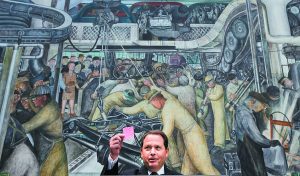The Federal Reserve voted to lower interest rates by a half percentage point, opting for a bolder start in making its first reduction since 2020. The long-anticipated pivot followed an all-out fight against inflation the central bank launched two years ago.
Eleven of 12 Fed voters backed the cut, which will bring the benchmark federal-funds rate to a range between 4.75% and 5%. Quarterly projections released Wednesday showed a narrow majority of officials penciled in cuts that would lower rates by at least a quarter point each at meetings in November and December.
Fed Chair Jerome Powell’s decision to trim rates by a larger amount than most analysts anticipated until just a few days ago moved the central bank unwaveringly into a new phase of its inflation battle: It is now trying to prevent past rate increases, which last year took borrowing costs to a two-decade high, from further weakening the U.S. labor market.
“The committee has gained greater confidence that inflation is moving sustainably toward 2%, and judges that the risks to achieving its employment and inflation goals are roughly in balance,” the Fed said in its policy statement Wednesday. The rate cut reflected both “the progress on inflation and the balance of risks.”
Anticipation of rate cuts buoyed Wall Street in the run-up to this week’s meeting, with the Dow Jones Industrial Average hitting a new record on Monday. Yields on the 10-year Treasury note stood at 3.64% on Tuesday, ticking up slightly from a 52-week low recorded on Monday.
The decrease should provide some immediate relief to consumers with credit card balances and to small businesses with variable-rate debt. Long-term borrowing costs—on everything from mortgages to corporate debt—have already been declining in anticipation of a series of rate cuts this fall, particularly after Powell last month said reductions were on the way.
A rate cut never appeared to be in doubt this week, but analysts were uncharacteristically foggy over the size of the move. Many anticipated a smaller quarter-point cut. Fed officials have often preferred to make smaller changes in order to avoid having to reverse course if their moves prove premature.
Powell’s apparent decision to push his colleagues to make a half-point cut likely reflected so-called risk management concerns in which officials weigh the risks of various economic hazards, such as high inflation or rising joblessness, and navigate accordingly
For most of the past 2½ years, as inflation hit 7%, Powell had been single-mindedly focused on preventing inflation from becoming entrenched. Central bankers have long been haunted by the example of the 1970s, in which they took insufficient steps to constrain demand and allowed expectations of higher prices to become self-fulfilling.
But inflation has fallen over the last year, assisted by healed supply chains and a steady influx of workers to the job market. That suggests the downturn many economists once thought might be needed to tame inflation would now be overkill.
Meantime, more signs that the job market is softening have cropped up. The unemployment rate stood at 4.2% last month, up from 3.7% in January. Powell last month signaled he was shifting the Fed’s attention to preventing what for now looks like a gentle cooling in labor demand from turning into a deeper freeze.
In their projections, all Fed officials thought the unemployment rate would end the year between 4.2% and 4.5%. In June, most saw the unemployment rate settling around 4.0% at year-end.
While some Fed officials had argued in recent weeks the economy wasn’t weak enough to necessitate a half-point cut, others had concluded that labor-market cooling this summer warranted a larger reduction because the Fed was, in effect, catching up for lost time.
Fed officials entertained but opted against cutting interest rates at their previous meeting at the end of July. Two days later, hiring figures showed a sharper-than-expected slowdown in payroll growth and a bigger jump in unemployment. While central bankers don’t get mulligans, they might have opted for a cut if that data had been in front of them at the July meeting. A larger cut this week offered the chance to reset.
Some officials also feel greater urgency to cut rates because they are increasingly confident that rates are well above a so-called neutral level that neither spurs nor slows growth, and that rates will continue to be at a restrictive level even after Wednesday’s cut. With the economy closer to a healthy equilibrium, keeping conditions there could call for moving rates closer to this neutral level, which can’t be observed.
Fed governor Michelle Bowman dissented against Wednesday’s decision in favor of a smaller quarter-point cut. Bowman, who was appointed to the board by Donald Trump in 2018, became the first governor to dissent against an interest-rate decision since 2005. It was the first dissent by any voter on the rate-setting committee since June 2022.



